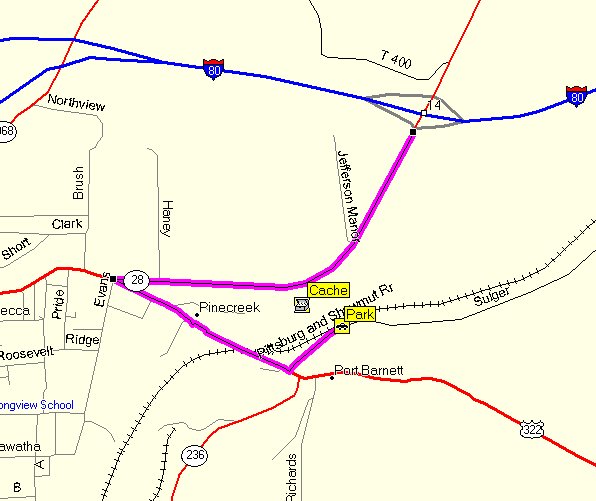Please park at N41°09.521
W079°03.008 along Sulgar road and hike north to the cache
location. Approaching the cache from the north is not
authorized. Take Rt 28 then east on Rt322. Turn NE onto
Sulgar road.

Shortly before the turn of the 20th century a Brookville teacher
at the Clear Run School, one Douglas Stahlman, became involved in
some sort of physical altercation with a big lumberjack who seems
to have put an awful whupping on him. Medical procedures in
those years were not what they are today. Nonetheless, a
steel plate was put in the skull of this guy who did not seem to
have the sense to stay out of Saturday night brawls with
lumberjacks.
Either the plate worked loose, put some undue pressure on a
section of his gray matter, or perhaps Mr. Stahlman was inclined
that way even prior to his squaring off with the Jefferson County
Paul Bunyan, but he came down with a heavy dose of religion about
that time. Whatever the reason, whether it was the indiscreet
teacher's close call with his own early demise or because of the
influence of the faith healer and bible thumper Dr. John Dowie of
Chicago, founder of the Zion settlement in Illinois, his life took
a dramatic turn. He proceeded to leave us some of the most
fantastic examples of misdirected energy and zeal that one is
liable to encounter anywhere on the planet.
For the next seven years (1907-1914), Stahlman would cover the
rocks and Beech trees at about five different locations around his
hometown with as many as 2500 lines of carved scripture. (A
conservative guess would be somewhere around 15,500 letters).
Eventually someone noticed that the behavior of this gentleman
was something less (or more) than normal and after the fashion of
the day, they had him installed in an institution for the mentally
deficient, (a contemporary politically correct term which in
Stahlman's day would have been called something much more clear in
the meaning, if a bit insensitive.) Here he remained as
librarian for the remainder of his days until he died about
1937.
Years have made the carvings upon the trees illegible scars, and
moss and leaves have covered many of the passages on the rocks, but
ample evidence of this fantastic project still remain for the
curiosity seeker to observe and ponder.
As one walks along the trail, you become conscious in a rather
eerie way that the stones all bear the faint traces of literally
thousands of carved words, and that each separate carving is
credited to chapter and verse from some book in the Bible.
Some of these carvings cover surfaces as large as the floor of a
room, some are carved along the narrow edges of stones jutting
sideways from the earth, some are carved under overhangs or along
ridged strata. Depending where they were carved determines
the legibility but probably all of them could be translated by
rubbings. Here and there one encounters a stone where dark
moss has grown inside the letters making those lines stand out as
if they were painted.
All in all over 500 separate examples are said to exist.
Doing the math reveals that one would have had to be completed
every five days if he worked every day, winter and summer without
taking off weekends or holidays for the seven years. This
does not take into any account the number of lines, words or
degrees of difficulty dictated by the locations of each particular
carving.
It is probably one of the most bizarre examples of obsessive
human behavior that anyone is apt to encounter anywhere.
Once you have found the cache follow the path west along the
hillside to find more, more and even more carved rocks. The
trail turns downhill to the railroad tracks and you can return to
the parking spot easily. Look around. The area is vast. Once you
have a feel for what you are looking for, you can find carved rocks
all over. Find a big flat stone covered with leaves? Kick off the
leaves to find more carvings. See a tall pointed rock along the
railroad? Go and notice how the word "DEATH" is in extra huge block
letters upon it.
This is not the only location in the Brookville area that
displays Stahlman's work and I encourage cachers to find more
examples and post their waypoints here. Please include as many
pictures and as much info as possible! Since so little is known
about this phenom, (the only published info I have found is
referenced below) I hope to use this cache page to gather as much
data and info as possible and prevent this peculiar story from
slipping into obscurity. Here are descriptions to the other
general areas that are known.
1. Old Brookville Park,
along Sugarcamp Run, between North Fork and junction of two
township roads near SR 0968
2. On US 322, south
side of road in wooded lot just east of and across from the
Pinecreek Fire Hall. (Large beech tree just east of stucco
bungalow)
3. At Port Barnett east and
south of Humphrey Charcoal office, which stands where pioneer
Joseph Barnett had his inn and store (on rocks)
4. Along Pennsylvania
Railroad at deserted lumbering village of Bells, near Sandy Lick
Creek and south of Pinecreek School. (Rock carvings cover
area of possibly two miles on hillside)
Portions of this text were blatantly plagiarized from Dick
Dornisch's article in The St. Marys Daily Press (Oct 19,
1996) and A Guidebook to Historic Western Pennsylvania. by
Helene Smith and George Swetnam (1991)